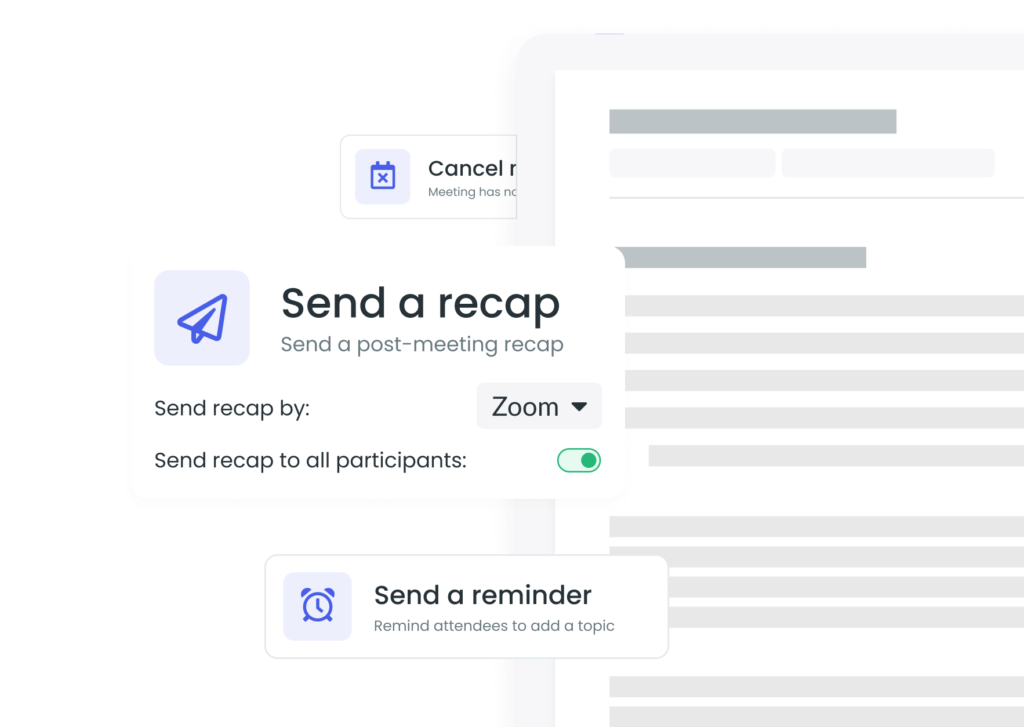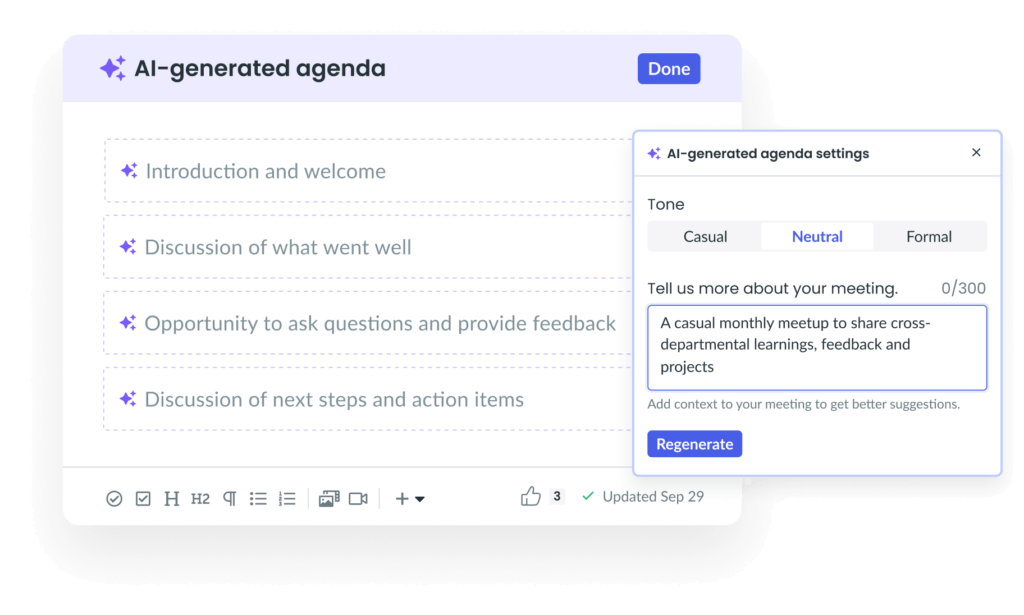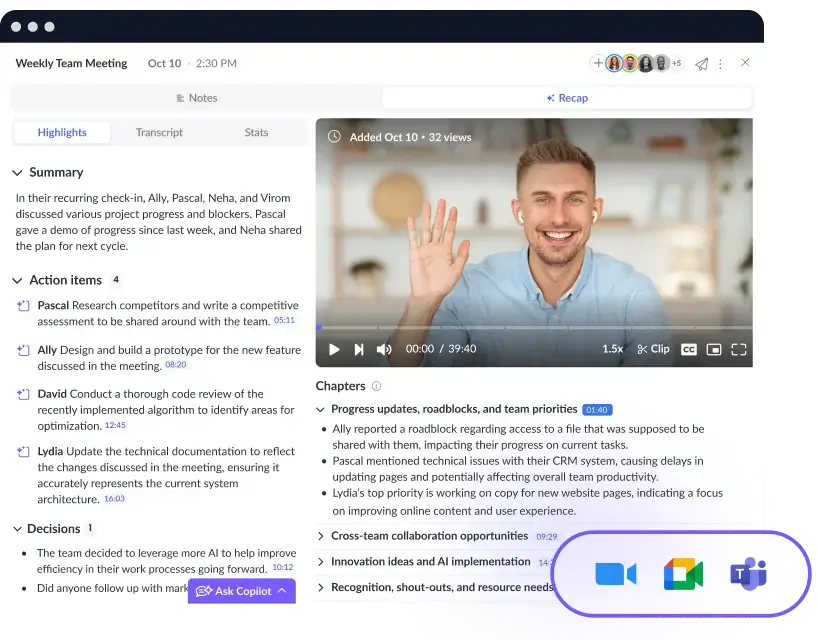Workplace Automation: Enhancing Efficiency in Today’s Business
Discover these best practices on implementing workplace automation technology — maximize your efficiency in 2024.
Already, 67% of companies use some sort of automation in their workplace to save time on repeatable tasks. While the concept of automation dates back to machinery innovations in the Industrial Revolution, or possibly even earlier, the adoption of digital workplace automation is still on the rise. If you’re looking to hop on this new wave to save some time and stress, you’ve come to the right place!
- What is workplace automation?
- Benefits of workplace automation
- Examples of workplace automation
- 6 best practices for implementing workplace automation
- How to automate your workflow with Fellow
What is workplace automation?
Workplace automation leverages technology to complete repeatable tasks automatically. It does this by having a “trigger,” which is a certain event that tells the automation workflow to kick off. From there, the technology will automatically conduct a specified sequence of events for you. This can save you a lot of time at work!
Forbes Books author Scott Cawood gives this advice for identifying where you can implement workplace automation:
“Take a hard look at your current systems: What pieces of the work can be outsourced to a machine? What new jobs can be created for humans by doing so? How can technology heighten the work experience for people?”
Benefits of workplace automation
- Saves time and money
- Improves employee satisfaction
- Reduces work overload
- Increases productivity
- Enhances work consistency
Saves time and money
The easiest benefit to measure when it comes to workplace automation is the money and time savings. Without a doubt, having the technology to automatically complete repeatable tasks for you will allow you to spend more time on deep work and strategic tasks.

Use AI to run efficient meetings and get back to work
Harness the power of AI to save time, get inspired, and enable efficient meeting preparation. Get AI-generated suggested agendas, topics, and talking points right where your meetings happen.
Improves employee satisfaction
Automation is frequently used so that teams no longer need to do tedious tasks like data entry. Allowing employees to step away from these energy-draining tasks will make them happier and more motivated to put their knowledge into growing the company.
Reduces work overload
As your team scales, the amount of data and information that needs transferring or updating will continuously increase; this can lead to eventual work overload. Help your team get some of these responsibilities off their plate by automating them!
Increases productivity
Context switching occurs when you’re required to do multiple tasks at once. To avoid this, automation helps increase productivity by managing some tasks in the background. This gives you more time to focus on your projects rather than handling the mundane details.
Enhances work consistency
When you’re manually updating tracking systems, there’s a risk of human error. With automation, this risk goes away! As a result, you’ll have much more consistent work, and you’ll no longer need to do as much quality assurance review.
Examples of workplace automation
Payroll
Payroll is a great first area to introduce workplace automation as it’s a recurring and stable activity. You can set the sequence up so that on every payday, the system automatically pulls the specified amount of money from the company account and deposits it into the employee’s account.
Reminder emails
Managers and administrative assistants manage many meetings and projects, so it’s a good idea to set automatic reminder emails that will notify team members of upcoming due dates, new action items, or project updates. This means you’ll spend less time pestering your team, and they’ll still get reminded to stay on top of their work!
With Fellow, you can easily set up pre-meeting reminders to be sent to the meeting attendees so you can focus on everything else going on in your work day. This will remind your team members to add their own thoughts and ideas ahead of time and help shape the meeting. After the meeting is wrapped, you can use Fellow’s automated post-meeting recap feature to send out the notes to all the stakeholders so that everyone is on the same page.
Chatbots
Customer service representatives can leverage chatbot automation tools to qualify cases before a human agent manages them. The automated chatbot can answer any frequently asked questions instantly. From there, any complex questions can be directed to a human representative. This reduces how much time is spent on redundant or unnecessary cases.
Account management
Sales managers oversee a lot of relationships at once, which can make it easy to forget to check in with clients. Thankfully, automation can send reminders about when to follow up via email, or it can even automatically distribute an email on your behalf when a client engages with a predetermined action, such as clicking on an important link!
6 best practices for implementing workplace automation
- Automate repetitive tasks
- Calculate the ROI
- Choose a tool that is user-friendly
- Involve employees from the beginning
- Implement cybersecurity solutions
- Continuously monitor and refine
Automate repetitive tasks
The first thing you should do when implementing your workplace automation software is to determine which tasks to automate! Think of any work that is easily repeatable and is done daily or weekly. You’ll also need to identify the triggers that will signal the automation to start. For example, it could be to start an email sequence when a new lead submits a form online. Or, it could be as simple as notifying a team member three days before a deliverable is due.
Calculate the ROI
The return on investment (ROI) of your investment should be clear before you actually make the purchase. Talk with a sales team at the vendor organization to see if they have any customer stories from similar companies that can help you with your decision-making. Often, the easiest way to calculate ROI for an automation tool is to determine the expected time savings from it.
Choose a tool that is user-friendly
Opt for an automation platform that will be easy for your team to learn. If your team is struggling to onboard and set up the tool, it’s likely that they won’t get the full value out of the product, which diminishes your ROI.
Reading sites like G2 will give you first-hand insights into how user-friendly a given product is. For example, Angelo F. said this about Fellow on G2:
“I must also commend Fellow.app for its user-friendly interface. Navigating the app is a breeze, thanks to its intuitive design. Whether I’m accessing Fellow.app on my desktop or on-the-go with the mobile app, the experience remains consistently smooth.”
Involve employees from the beginning
Your team members likely have some areas where they’ve identified friction or feel like they’re spending too much time. It’s a best practice to have a conversation with your team about the benefits of automation. From there, you can work together to see how automated sequences can solve some of the problems you’re currently facing! They might even want to try any platforms you’re considering to ensure the chosen platform meets their needs.
Implement cybersecurity solutions
Cybersecurity is super important yet so underrated! Automation tools integrate with a lot of other software tools, which can make you more susceptible to a cyber attack. When you’re considering adopting a new workplace automation platform, keep your digital transformation and security teams in the loop, as they might have some insights on best practices in this area.
Continuously monitor and refine
As you get up and running with your platform of choice, you’ll need to continuously optimize your sequences. As an example, if you’re using automation to follow up on sales activity, try to measure how much engagement and conversion you get from various types of automation. Use the results of your experiments to drive the most revenue possible.
Anytime that a process or technology changes, check back in on your automated workflows to ensure they’re still compatible with your newest set-up.
How to automate your workflow with Fellow
Fellow is a meeting management platform with plenty of automation to help ease your day-to-day work! Meeting automations can do a lot to save time, regardless of whether you’re a meeting host or attendee. They are quick to set up and can help you do things like:
- Remind participants of upcoming calls
- Send meeting recap notes to attendees
- Offer suggested talking points for the meeting agenda
- Distribute feedback surveys at the end of a presentation
You don’t need to have a live call to leverage meeting automations, either. Asynchronous meetings can also benefit from automation in the same way. For example, instead of relying on the meeting host to check in at the end of the meeting period to see who has contributed, you can use Fellow to automatically generate a summary and email it to all of the participants. This is a huge help to reduce the mental load of team leads or project managers who might be overseeing multiple meetings on any given day!
Fellow is a great (and affordable) option for any team that needs to make communication efforts more efficient. Workplace automation through Fellow can help your team stay on track, keep aligned on goals, and collaborate seamlessly across all of the productivity tools you use—like Zoom, Jira, or Slack.

Parting advice
As your team scales, it’s important to consider the efficiency of your work. The more time you can spend focused on strategic initiatives, the faster you’ll grow! While considering which workplace automation tool to adopt, keep your employees in the loop so they can provide feedback and insights that will ensure you make the right selection. When in doubt, don’t hesitate to do a free trial to get a first-hand feel for how the tool will work for your team!












